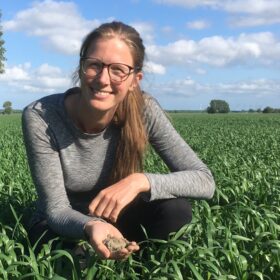Book Chapters:
Papathoma-Köhle M., Dominey-Howes D., in Press. Risk Governance of No-notice or Limited-Notice Natural Hazards, Oxford Encyclopedia of Risk Governance, accepted for publication
Papathoma-Köhle M., Thaler T., in Press. Institutional Vulnerability In: Fuchs S. and Thaler T. (Eds) Vulnerability and Resilience to Natural Hazards. Cambridge University Press, accepted for publication
Fuchs, S. and Papathoma-Köhle, M. 2017. Strengthening local capacities for effective response. In: Wymann von Dach, S., Bachmann, F., Alcántara-Ayala, I., Fuchs, S., Keiler, M., Mishra, A. & Sötz, E., (eds). Safer lives and livelihoods in mountains: Making the Sendai Framework for Disaster Risk Reduction work for sustainable mountain development. Bern, Switzerland, Centre for Development and Environment (CDE), University of Bern, with Bern Open Publishing (BOP). 78 pp.
Papathoma-Köhle M., Ulbrich T. Keiler M., Pedoth L. Totschnig R., Glade T., Schneiderbauer S., Eidswig U. Vulnerability to Heat Waves, Floods and Landslides in Mountainous Terrain: Test cases in South Tyrol. In: Birkmann J., Kienberger S., Alexander D.E. (eds): Assessment of Vulnerability to Natural hazards, a European, Perspective, Elsevier. Pp. 179-201.
Papathoma-Köhle M. and Glade T., 2013. The role of vegetation cover change for landslide hazard and risk. In: G. Renaud, Karen Sudmeier-Rieux and Marisol Estrella (eds): The Role of Ecosystems in Disaster Risk Reduction. UNU-Press, Tokyo. pp. 293-320.
Puissant, A., Van Den Eeckhaut, M., Kappes, M., Papathoma-Köhle, M., Keiler, M., Hervás, J., Malet, J.P. 2013. Index-oriented methodologies for landslide consequence analysis: an application to a mountain community in the French Alps. In: Margottini C., Canuti P., Sassa K. (eds.) Landslide Science and Practice, Vol. 7, 159-167.
Peer-reviewed Journals:
Papathoma-Köhle M., Gems B., Sturm M., Fuchs S. Matrices and indicators: a review of approaches to assess physical vulnerability to debris flows. Accepted for publication to Earth Sciences Reviews.
Papathoma-Köhle M., 2016. Vulnerability curves vs. vulnerability indicators: application of an indicator-based methodology for debris-flow hazards. Natural Hazards and Earth System Sciences, 16(8): 1771-1790.
Papathoma-Köhle M., Promper C., Glade T., 2016. A Common Methodology for Risk Assessment and Mapping of Climate Change Related Hazards-Implications for Climate Change Adaptation Policies. Climate, 4(1) doi:10.3390/cli4010008
Papathoma-Köhle M., Promper C. Bojariu R., Cica R., Sik A., Perge K., Lazlo P., Balazs Czikora E., Dumitrescu A., Turcus C., Birsan M-V., Velea L., Glade T. 2016. A common methodology for risk assessment and mapping for Southeast Europe: an application for heat wave risk in Romania, Natural Hazards, Vol.82, Supplement 1, 89-109.
Markovic V., Nagy I., Sik A., Perge K., Lazlo P., Papathoma-Köhle M., Promper C., Glade T. 2015. Assessing drought and drought related wildfire risk in Kajiza, Serbia. Natural Hazards, Online first, DOI 10.1007/s11069-015-1991-4.
Papathoma-Köhle M., Zischg A., Fuchs S., Glade T., Keiler M., 2015. Loss estimation for landslides in mountain areas- An integrated toolbox for vulnerability assessment and damage documentation. Environmental Modelling and Software, 62, 156-169.
Eidsvig U.M.K., Papathoma-Köhle M., Du J., Glade T. And Vangelsten B.V., 2014. Quantification of model uncertainty in debris flow vulnerability assessment. Engineering Geology, 181, 15-26.
Schwendtner B., Papathoma-Köhle, Glade T., 2013. Risk evolution: How can changes in the built environment influence the potential loss of natural hazards? Natural Hazards and Earth System Sciences, 13, 2195-2207
Papathoma-Köhle M., Keiler M., Totschnig R., Glade T., 2012. Improvement of vulnerability curves using data from extreme events: a debris flow event in South Tyrol. Natural Hazards, Published online first 09 March 2012. DOI: 10.1007/s11069-012-0105-9
Tarbotton C., Dominey-Howes D., Goff J., Papathoma-Köhle M., Dall'Osso F., Turner I.L., 2012. GIS- based techniques for assessing vulnerability of buildings to tsunami-current approaches and future steps. Geological Society, London, Special Publications, 2012361:115-125
Kappes, M.S.; Papathoma-Köhle, M. & M. Keiler, 2012. Assessing physical vulnerability for multihazards using an indicator-based methodology. Applied Geography, 32, 2, 577-590
Papathoma-Köhle, M.; Kappes, M.S.; Keiler, M. & T. Glade. 2011. Physical vulnerability assessment for alpine hazards: state of the art and future needs future needs. Natural Hazards 58, 2, 645-680
Dominey-Howes D., Dunbar P., Varner J., Papathoma-Köhle M., 2010. Estimating Probable Maximum Loss from a Cascadia tsunami, Natural Hazards, 53, 1, 43-61
Kaynia A., Papathoma-Köhle M., Neuhaeuser B., Ratzinger K., Wenzel H., Medina-Cetina Z., 2008. Probabilistic Assessment of Vulnerability to Landslide: Application to the village of Lichtenstein, Baden- Württemberg, Germany. Engineering Geology, 101 (1-2), 33-48.
Papathoma-Köhle M., Neuhaeuser B., Ratzinger K., Wenzel H., Dominey-Howes D., 2007. Elements at risk as a framework for assessing the vulnerability of communities to landslides. Natural Hazards and Earth Systems Science, 7,765-779. Available online: http://www.nat-hazards-earth-syst-sci.net/7/765/2007/nhess-7-765-2007.pdf
Neuhaeuser B., Papathoma M., Ratzinger K., 2007. Geographic Information Systems and Multi-Criteria Assessment of Landslide Susceptibility Applied on the Swabian Jura, Germany. In: Crosta G.B. and Frattini P. (Eds) Landslides: From mapping to Loss and Risk Estimation, LESSLOSS report 2007/01, IUSS Press, Pavia, ITALY, p. 155-161.
Dominey-Howes, D., Papathoma- Köhle M., Bird D., Mamo B., Anning D., 2007. The Australian Tsunami Warning System and lessons from the 2 April 2007 Solomon Islands Tsunami alert in Australia (Letter to the editor) Natural Hazards and Earth Systems Science, 7, 571-572. Available online: www.nat-hazards-earth-syst-sci.net/7/571/2007/nhess-7-571-2007.pdf
Dominey-Howes D., Papathoma M., 2007. Validating the "Papathoma Tsunami Vulnerability Assessment Model" (PTVAM) using field data from the 2004 Indian Ocean tsunami. Natural Hazards, 40,1,113-136.
Wechselbaum J., Petrini-Monteferri F., Papathoma M., Wagner W., Hackner N., 2005. Sharpening census information in GIS to meet real-world conditions-the case for earth observation. Accepted for publication in: Proceedings of the Second International Conference on Sustainable Planning and Development, 12-14 September 2005, Bologna, Italy.
Papathoma M., Dominey-Howes D., Zong Y., Smith D., 2003 Assessing Tsunami Vulnerability, an example from Herakleio, Crete. Natural Hazards and Earth System Science, 3, 377-389. The full paper is available online: www.nat-hazards-earth-syst-sci.net/3/377/2003/nhess-3-377-2003.pdf
Papathoma M., Dominey-Howes D., 2003. Tsunami vulnerability assessment and its implications for coastal hazard analysis and disaster management planning, Gulf of Corinth, Greece. Natural Hazards and Earth System Science, 6, 733-744. The full paper is available online: http://www.nat-hazards-earth-syst-sci.net/3/733/2003/nhess-3-733-2003.pdf
Conference Proceedings (Papers)
Papathoma-Köhle M., Totschnig R., Keiler M., Glade T., 2012. A new vulnerability function for debris flow-The importance of physical vulnerability assessment in alpine areas. 12th Congress INTERPRAEVENT 2012-Grenoble/France, conference Proceedings, 1033-1043.
PRESENTATIONS IN CONFERENCES/WORKSHOPS:
Sturm, M; Gems, B; Aufleger, M; Mazzorana, B; Papathoma-Köhle, M; Fuchs, S (2017): Scale model measurements of impacting forces on obstacles induced by bed-load transport processes. IAHR World Congress 2017, AUG 13-18, 2017, Kuala Lumpur
Sturm, M; Gems, B; Keller, F; MAzzorana, B; Fuchs, S; Papathoma-Köhle, M; Aufleger, M (2017): Einwirkungen fluviatiler Geschiebetransportprozesse auf Gebäude. Fachtagung Naturgefahren an der Versuchsanstalt Obernach, JUL 6, 2017, Jachenau
Papathoma-Köhle M., 2017. Vulnerability of buildings to Natural Hazards. (Invited Speaker) in the 4th Conference on Civil Protection and High-End Technologies “Safe Athens 2017” held on 28-30 June 2017 in Athens, Greece.
Papathoma-Köhle M., Thaler T., Fuchs S. 2017. Resilience of the built environment: the way forward in Disaster Risk Reduction? A new framework and preliminary results from the European Alps (Presentation). Association of American Geographers (AAG) Annual Meeting in Boston, April 5-9 2017.
Papathoma-Köhle M., Totschnig R., Keiler M., Glade T., 2012. A new vulnerability function for debris flow-The importance of physical vulnerability assessment in alpine areas. 12th Congress INTERPRAEVENT 2012-Grenoble/France
Papathoma-Köhle M., Physical vulnerability assessment for alpine hazards: a vulnerability curve for loss estimation of debris flow events. Workshop on "Challenges for assessing future flood losses", Innsbruck 22 and 23 March 2012 (organized by AlpS and University of Innsbruck).
Papathoma-Köhle M., Keiler M., Totschnig R., Glade T., 2011. Improvement of vulnerability curves using data from extreme events: a debris-flow event in South Tyrol. Proceedings of the EGU General Assembly 2011, 3-8 April 2011, Vienna, AUSTRIA.
Papathoma M., Dominey-Howes D., Zong Y., Smith D., 2002. Tsunami Vulnerability Assessment for Greece. Conference Proceedings of the Second Tsunami Symposium, May 28-30, Honolulu, Hawaii, U.S.A.




















